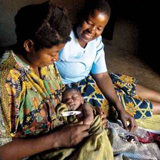
The most dangerous time in a child’s life is during birth and shortly thereafter. Newborn babies – those in their first four weeks of life – account for over 40 percent of deaths among children under age 5. Childbirth is also a very risky time for mothers in the developing world, around 50 million of whom give birth each year at home with no professional help whatsoever.
If we want to solve the interconnected problems of maternal and newborn mortality, we must do a better job of reaching these mothers and babies with skilled care during pregnancy, childbirth, and the minutes, days and weeks following birth. For a variety of reasons, in many parts of the world, pregnant women and young children will not receive lifesaving health care unless there is a female health worker nearby to provide it.
This year’s State of the World’s Mothers report examines the many ways women working on the front lines of health care are helping to save the lives of mothers, newborns and young children. It shows how investments in training and deploying female health workers have paid off in term of lives saved and illnesses averted, and it points to low cost, low-tech solutions that could save millions more lives, if only they were more widely available and used.
Key findings
- An alarming number of countries cannot provide the most basic health care that would save mothers’ and children’s lives.
- Female health workers have an especially critical role to play in saving the lives of women, newborns and young children.
- Relatively modest investments in female health workers can have a measurable impact on survival rates in isolated rural communities.
- The most effective health care often begins at home, or very close to home.
- Countries that train and deploy more front-line female health workers have seen dramatic declines in maternal, newborn and child mortality.
Recommendations
- Train and deploy more health workers – especially midwives and other female health workers.
- Provide better incentives to attract and retain qualified female health workers.
- Invest in girls’ education.
- Strengthen basic health systems and design health care programs to better target the poorest and most marginalized mothers and children.